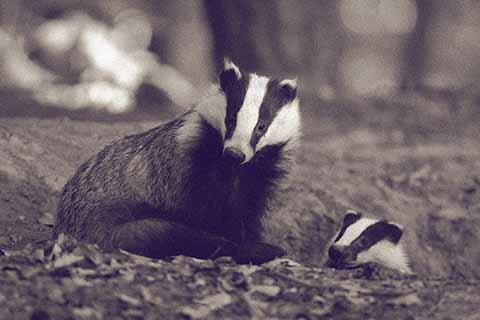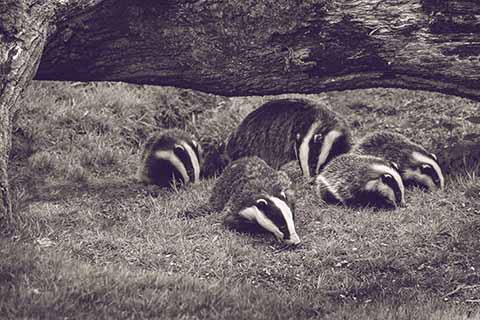Badgers and a broken neck
Malcolm D Welshman recounts a particularly memorable spell of badger watching in Throop
Published in May ’19

Alerted by their mother’s call, the youngsters squeaked in alarm and bolted back to the safety of their sett
A ball of grey fur shot out of the holly thicket, bounced down the bank and careered into my ankles. Shaken, the two badger cubs sprang apart from their tussle. Piggy black eyes blinked at me, puzzled. Moist grey nostrils quivered, uncertain. At the top of the bank a striped black and white head appeared. There was a warning yelp. Alerted by their mother’s call, the youngsters squeaked in alarm and bolted back to the safety of their sett.
It was a badgers’ sett I had discovered during my sixth form days at Bournemouth Grammar School, back in the late ’sixties. It was only ten minutes’ cycle ride from my home in West Way: over Castle Lane and then a swoop down the country lane to Throop. That badgers’ home was hidden on a bank in the dappled fringes of woodland behind the back gardens of a row of bungalows. Along the bank on the edge of those woods was scattered a mound of freshly dug, rich red soil. Above it, a gaping hole – the entrance to a badger’s sett.
On my first visit it was May-time. Beech and hawthorn had unfurled their mantles of soft green. I climbed branch by branch into the crook of a beech bough which overhung the bank. It gave me a bird’s eye view of the sett, safe from noses scenting for danger. As the sun dipped below the tree line in a blaze of orange, a sylph-like form, a roebuck, slipped into the meadow that stretched down to the River Stour and began to graze in the gathering grey. A blackbird zoomed into the holly thicket below me, clackering with alarm. Three woodpigeons crashed in to roost, then, having spotted me, whirled away in a frenzy of flapping wings.
I fixed my eyes on the sett’s darkening entrance. It suddenly filled with a blur of black and white. A badger stood there motionless, listening. Quietly he slipped out and sniffed the air, paw raised. A smaller, slimmer badger appeared behind him. A sow. His mate. They touched noses and purred. Then the sow rolled over and, with both front paws, gave her belly a hearty scratch, lips curled back in a blissful grin.
It was on my second visit in June of that year when those cubs hurtled down the bank to bump into me. Four in all, they were that sow’s offspring. During the long, golden early June evenings, they played, fought and chased each other. Up and down the bank they romped. The gnarled grey tangle of beech roots was worn smooth where king-of-the-castle was played in a boisterous tumult of squeals and squeaks, while the grass at the edge of the field was flattened by their play.
I continued to watch those cubs enjoy themselves on many evenings until one day my visits came to a dramatic end. That evening I had been sitting up in the beech tree, on a branch I had used many times before. As it got dark, the badgers moved off to forage and feed for the night. Time for me to go home. I hauled myself to my feet, my legs a little wobbly from sitting in one fixed position for nearly an hour. I reached up to steady myself by clutching the spindly branches above me. Suddenly there was a cracking, a splintering sound. I felt the branch on which I was standing start to bend down in the semi-darkness. Then, with a noise like a pistol shot, the branch gave way and I plunged down through the dense canopy of twigs and leaves, my arms and legs flailing as the ground rushed up to greet me.

‘It was on my second visit in June of that year when those cubs hurtled down the bank to bump into me. Four in all, they were [the] sow’s offspring.’
Did it put me off badger-watching again? No. But to be honest, not by sitting up in a tree. And I never did go back to that sett down at Throop. I like to think it is still there. Badgers are known to inhabit the same setts for many years. It would be good to think that the badgers who occupied that particular sett at the time weren’t put off by the human who hurtled to earth that warm summer’s evening so many decades ago, and that their descendants are still enjoying a precious brockland life in this hidden corner of Bournemouth.

